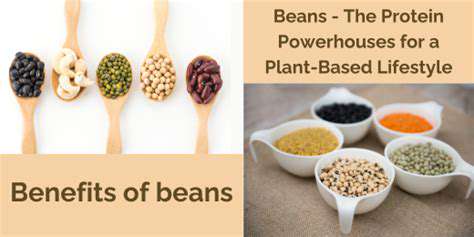Grains in the Mediterranean Diet
Grains are a cornerstone of the Mediterranean diet, providing essential carbohydrates for energy and a wide array of nutrients. The diet emphasizes whole grains over refined grains, highlighting the nutritional benefits of foods like brown rice, quinoa, and whole wheat pasta. These whole grains are packed with fiber, which aids digestion, promotes satiety, and helps regulate blood sugar levels, contributing to overall health and well-being. Their inclusion in the diet is crucial for maintaining a balanced and healthy lifestyle.
Choosing whole grains over refined grains is a key element of the Mediterranean diet's approach to nutrition. Refined grains often undergo processing, removing the bran and germ, reducing their fiber content and nutritional value. This difference in processing affects not only the fiber content, but also the vitamins, minerals, and antioxidants present. By opting for whole grains, you're not only fueling your body with essential nutrients but also supporting a healthier digestive system and overall well-being.
Importance of Whole Grains
Whole grains play a vital role in maintaining a healthy digestive system, providing essential fiber that promotes regularity and prevents constipation. The fiber content in whole grains also helps regulate blood sugar levels, preventing significant fluctuations that can impact energy levels and overall health. This is particularly important for managing conditions like type 2 diabetes, where stable blood sugar is critical.
Beyond digestive health, whole grains offer a range of essential vitamins and minerals, including iron, magnesium, and various B vitamins. These nutrients contribute to numerous bodily functions, from energy production to nerve function. Incorporating a variety of whole grains into your diet ensures a balanced intake of these crucial micronutrients.
Variety in Grain Choices
The Mediterranean diet encourages a diverse range of grain options, allowing for flexibility and enjoyment. From farro and bulgur to barley and oats, the possibilities are numerous. Each grain offers a unique flavor profile and texture, adding depth and interest to your meals. Experimenting with different grains allows for creative culinary exploration and ensures a satisfying and nutritious dietary experience.
Beyond the Plate: Grain Impact on Health
The impact of grains extends beyond the immediate taste and nutritional value. Studies have shown a correlation between a diet rich in whole grains and a reduced risk of chronic diseases, including heart disease and certain types of cancer. The fiber and antioxidants present in these grains contribute to a healthier cardiovascular system and overall well-being. This underscores the importance of incorporating whole grains as a fundamental part of a balanced and healthy diet.

Legumes: Plant-Based Protein Powerhouses

Legumes: A Nutritional Powerhouse
Legumes, a diverse group of plants encompassing beans, peas, lentils, and chickpeas, are a cornerstone of a healthy diet. These nutritional powerhouses are packed with essential nutrients, including protein, fiber, and various vitamins and minerals. Their nutritional density makes them a valuable addition to any meal plan.
Protein Power for Vegetarians and Vegans
For vegetarians and vegans, legumes are an excellent source of plant-based protein. They provide a complete protein profile, meaning they contain all nine essential amino acids the body needs but cannot produce on its own. This makes them a crucial component in a balanced vegetarian or vegan diet, ensuring adequate protein intake for optimal health and growth.
Fiber-Rich for Digestive Health
Legumes are renowned for their high fiber content. This soluble and insoluble fiber promotes healthy digestion, regulates bowel movements, and helps maintain a healthy gut microbiome. This is vital for overall well-being, impacting everything from energy levels to immune function. Furthermore, this fiber can help you feel full longer, which can aid in weight management.
Versatile in Culinary Applications
Legumes are incredibly versatile ingredients, finding their way into countless cuisines worldwide. From hearty soups and stews to flavorful salads and savory dishes, they are adaptable to a wide range of culinary preparations. Their versatility extends beyond the kitchen, as they can also be used in baked goods, snacks, and even desserts.
Sustainable and Eco-Friendly
Growing legumes is often more sustainable and environmentally friendly compared to other protein sources. They require fewer resources like water and pesticides, making them a more eco-conscious choice for consumers. This makes them a thoughtful and responsible food selection, contributing to a healthier planet.
Cost-Effective and Affordable
Legumes generally offer excellent value for money. Their affordability makes them a budget-friendly option for incorporating protein and fiber into your diet, especially beneficial for those on a tight budget. This affordability allows more people to benefit from their nutritional value.
Packed with Essential Nutrients
Beyond protein and fiber, legumes are also rich in various vitamins and minerals like iron, folate, potassium, and magnesium. These essential nutrients play critical roles in various bodily functions, contributing to overall health and well-being. The diverse nutrient profile of legumes makes them a valuable addition to any healthy diet.
Phase 2 clinical trials are crucial for evaluating the safety and efficacy of a potential new treatment. A well-designed Phase 2 trial should focus on determining the optimal dose and regimen for the drug candidate. This involves careful consideration of the study population, including factors such as age, gender, and the presence of comorbidities. A critical element is choosing appropriate outcome measures, ensuring they accurately reflect the treatment's impact on the target condition.
Spices and Herbs: Enhancing Flavor and Health

The Aromatic Wonders of Spices
Spices and herbs are more than just flavor enhancers; they are integral components of culinary traditions worldwide. Their aromatic properties, derived from various plant parts, contribute significantly to the complexity and depth of dishes. From the warm, earthy tones of cinnamon to the vibrant zest of ginger, these natural ingredients unlock a world of flavor possibilities, transforming simple meals into culinary masterpieces.
The diverse range of spices and herbs available is truly astounding, offering a spectrum of tastes and textures. Each type possesses unique characteristics, enabling chefs and home cooks to create a wide array of flavor profiles, from subtly sweet to intensely spicy.
Culinary Applications and Versatility
Spices and herbs are incredibly versatile in the kitchen. They can be used to season meats, vegetables, grains, and even desserts. Their ability to enhance existing flavors without overpowering them makes them invaluable in any culinary setting.
From adding a pinch of paprika to a roasted chicken to infusing a fragrant broth with bay leaves, spices and herbs can elevate any dish. Their use is not limited to savory dishes; they can also lend a unique touch to sweet treats, adding a layer of complexity and depth to desserts.
Health Benefits and Nutritional Value
Beyond their culinary applications, spices and herbs often possess significant health benefits. Many are rich in antioxidants, which help protect the body against cellular damage. Furthermore, some spices and herbs have been traditionally used for their medicinal properties, offering a range of potential health advantages.
For example, turmeric, known for its vibrant color and earthy flavor, is rich in curcumin, a powerful antioxidant with potential anti-inflammatory effects. Regular consumption of spices and herbs can contribute to a healthier lifestyle, offering both flavor and potential health advantages.
The History and Culture of Spices
The history of spices is intertwined with global trade routes and cultural exchange. For centuries, spices have been highly prized commodities, driving exploration and shaping economic landscapes across continents. Their value often transcended their mere culinary use, becoming symbols of wealth and status.
The use and appreciation of spices have evolved across different cultures, reflecting unique culinary traditions and historical influences. Each region has its own distinctive spice blends and methods of preparation, creating a tapestry of flavor that reflects its history and heritage.
Sustainable Sourcing and Ethical Considerations
With the increasing awareness of environmental sustainability, it's crucial to consider the ethical and sustainable sourcing of spices and herbs. Supporting farmers who use responsible agricultural practices is essential to ensure the long-term availability of these valuable ingredients while minimizing environmental impact.
Choosing spices and herbs from reputable suppliers who prioritize sustainability can support a more equitable and environmentally conscious food system. This conscious approach to sourcing not only ensures the quality of the product but also promotes a more sustainable and ethical food future.